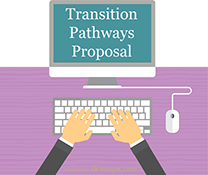Development of the Transition Pathways Proposal
September 23, 2016
 Like other stories on this site, the story of the Transition Pathways proposal is intended to offer a glimpse into the process by which new programs are developed or existing programs are improved. I hope that the steps outlined below help others to outline a plan of action for similar proposals.
Like other stories on this site, the story of the Transition Pathways proposal is intended to offer a glimpse into the process by which new programs are developed or existing programs are improved. I hope that the steps outlined below help others to outline a plan of action for similar proposals.
My role in this story began when I was recruited to Drexel in March 2015 specifically because of my experience, expertise, and scholarship in the design of programs of services and training for people with autism, by faculty who had been invited by a foundation to submit a proposal to develop new programs of services for transition aged adults.
- My colleagues and I immediately moved quickly to establish broad goals (i.e., to prepare adults on the spectrum to live independently and remain engaged with their communities, and to offer opportunities for both employment and lifelong learning in a college-based program that might be made accessible to a broad population). As we continued to develop the proposal, I sought to translate these goals into increasingly specific outcomes that could serve as goals for the overall program, and for individual participants. These goals also served as guideposts as we refined other program components.
- With these broad goals in hand, we then explored the extent to which existing models (like Project SEARCH, ThinkCollege, and FirstPlace Arizona) might help us to reach these goals. At this point, my colleagues and I recognized that no single, existing model addressed the range of goals we had initially identified. We established the need for a more thorough and comprehensive proposal that blended the best elements of existing program models, and new elements under consideration. We also established the need to clearly define the program before committing to develop a funding proposal for a dedicated building.
- To develop a more thorough and comprehensive proposal, we needed to outline a new kind of program in enough detail to establish cost estimates and timelines, and to anticipate opportunities and barriers. At this point, I assumed responsibility for the detailed analysis of the many different program components and combinations considered in preparation for the final Transition Pathways design; population, staffing, community-based partners, curriculum, evidence-based practices, settings, and public/private resources. I wrote the detailed funding proposal based on these analyses (with input from my colleagues), and led the development of other materials used in the actual presentation to the foundation.
- We presented a two-stage proposal in December 2015 to commit to: (a) launch programming beginning in September 2016, and; (b) submit a 2nd proposal for additional funding for a dedicated physical space to house the program as described, but including a community living option. Subsequent to the initial $3.5 million award in December 2015, I was tasked with leading the development of the second funding proposal that would create a dedicated physical space and an accompanying community living program (at an estimated additional $9 million).
The detailed description of the design process constitutes the case study or “story” which I hope will offer insights to others seeking to translate the broad aspirations that result from a general planning process, into specific programs that can be successfully implemented in community-based settings. This case study includes several components.
- The rationale behind the elements included in the final Transition Pathways design (population, staffing, community-based partners, curriculum, evidence-based practices, settings, public/private resources, and so on) are described elsewhere in the story of the Transition Pathways proposal.
- Many specific and important design elements in the Transition Pathways proposal were based on programs I had developed or led. In these cases, I link back to descriptions of these other programs available in About ASD Roadmap. Some of these descriptions are framed as specific lessons that may have implications for the development of other programs.
- Many of these design considerations are also addressed in my writings and/or presentations. In some cases, I link back to references in the Publications.
- Opinions offer other kinds of insights, weaving threads inspired by different stories on ASD Roadmaps or from other stories available on the Internet into lessons that might help guide developers of programs for people on the spectrum. In some cases, I provide links between these opinion pieces and the elements of the Transitions Pathways proposal.
Note that the descriptions offered here reflect the plans I had outlined for the program prior to my decision to resign from Drexel in February 2016, and so may not be integral to the program ultimately implemented.











